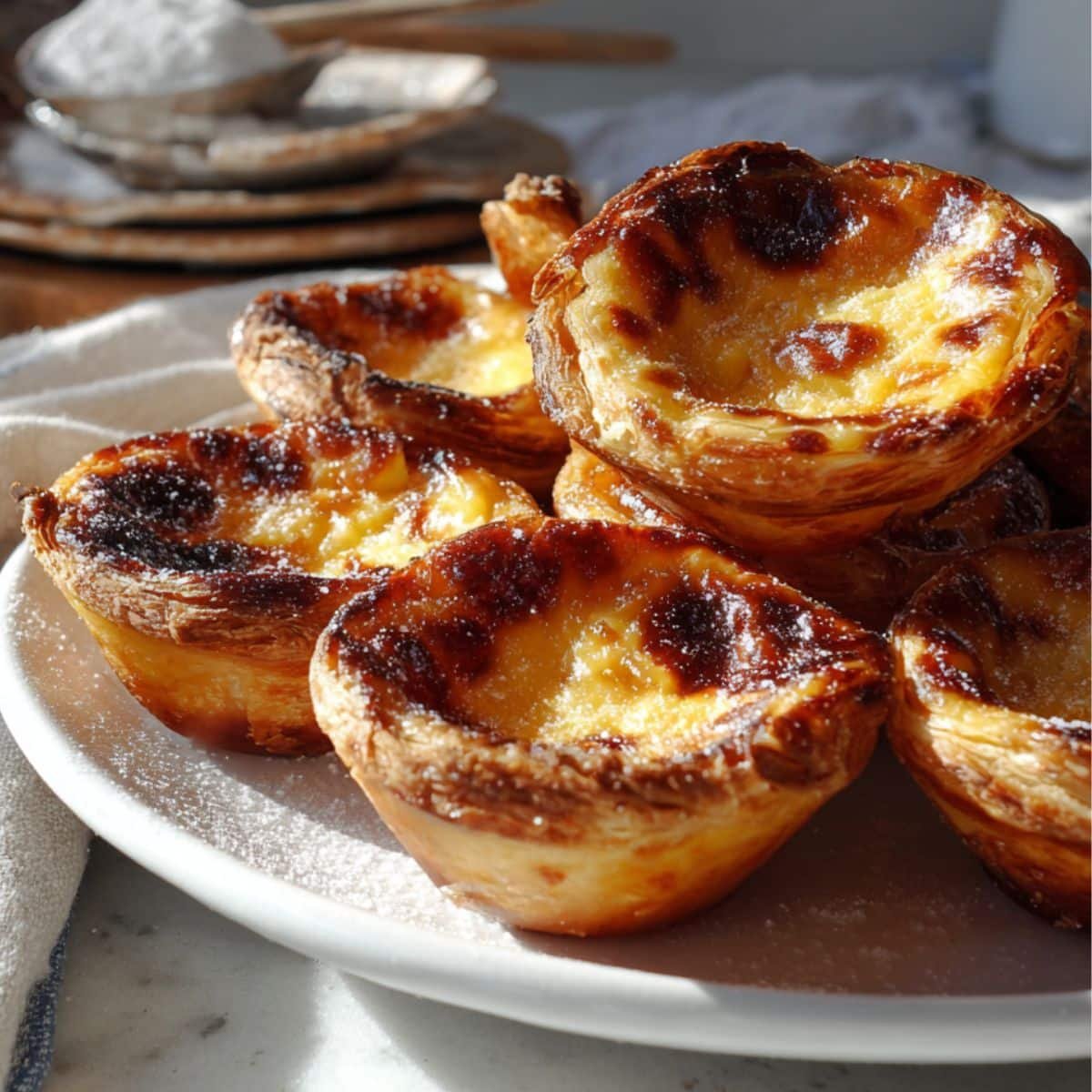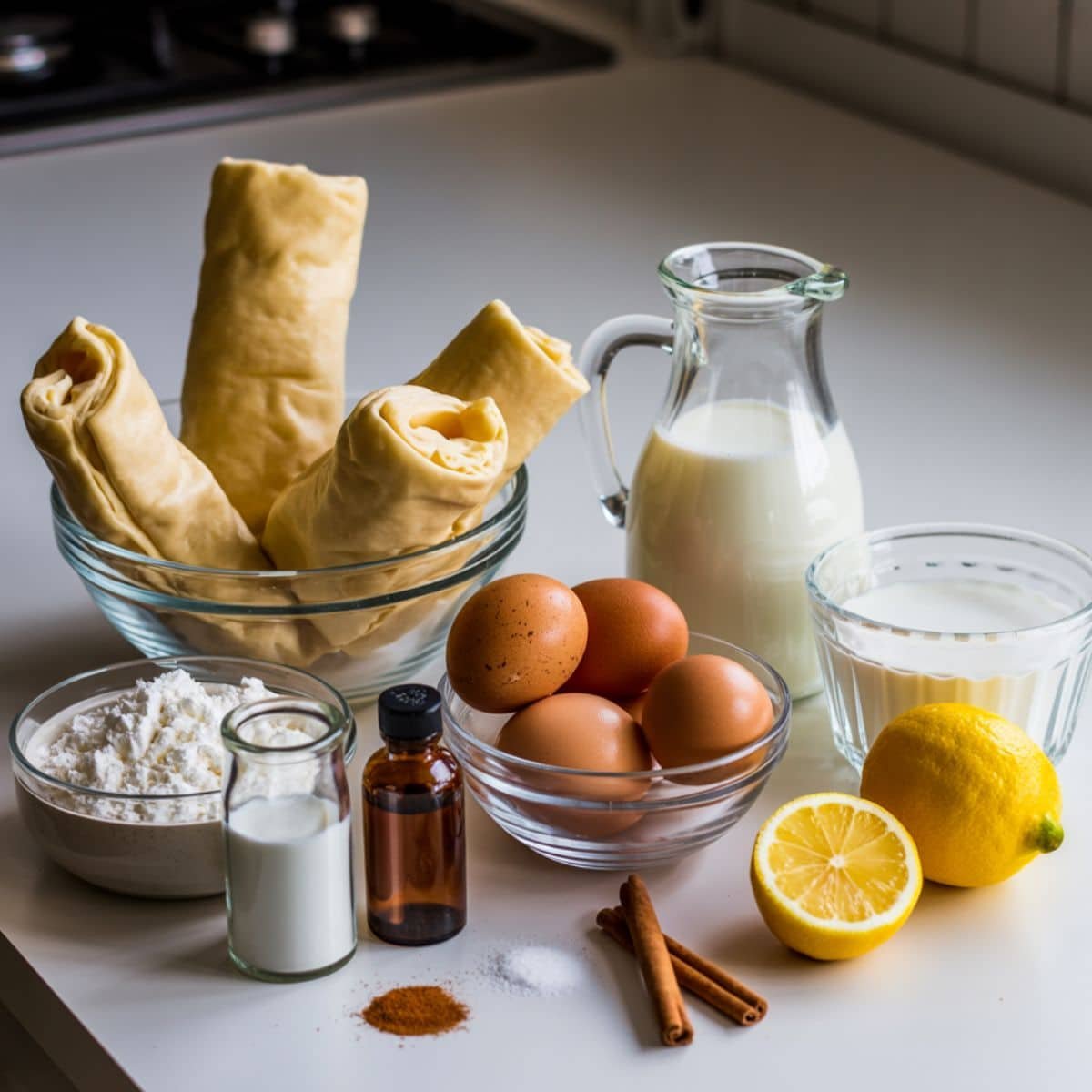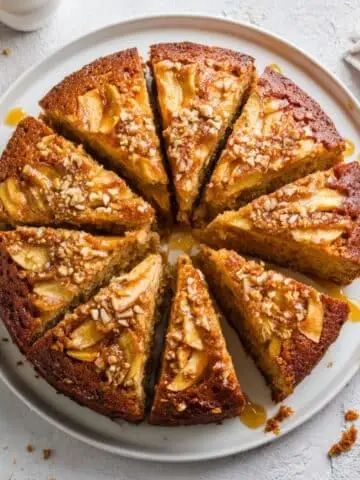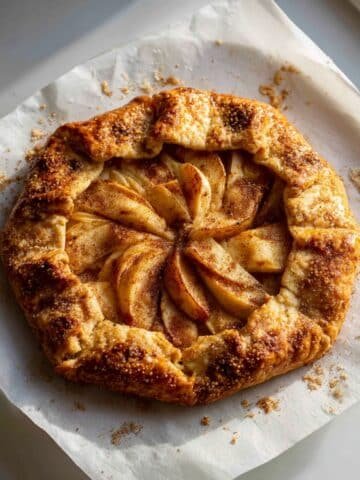If you've ever wandered the cobblestone streets of Lisbon, you know the irresistible aroma of freshly baked portuguese custard tarts wafting from every corner bakery. These golden treasures are Portugal's most beloved sweet treat, and today I'm sharing the secrets to recreating them in your own kitchen. The beauty of portuguese custard tarts lies in their perfect balance; a crispy, flaky puff pastry shell cradling a silky, caramelized egg custard filling that melts on your tongue.
Making portuguese custard tarts might seem intimidating, but I promise this authentic Portuguese custard tart recipe breaks down every step so clearly that even beginners can achieve bakery-style results. Whether you're craving a taste of Portugal or want to impress guests with homemade European pastries, these portuguese custard tarts will transport everyone straight to a sunny café in Lisbon with just one bite.

The Rich Heritage Behind Portugal's Iconic Treat
The history of portuguese custard tarts dates back to the 18th century when Catholic monks at Jerónimos Monastery in Belém created these pastries using surplus egg yolks. After the monastery closed in the 1830s, the recipe was sold to a nearby sugar refinery, and a famous bakery was born, still serving the original secret recipe today. This traditional Portuguese dessert has since become a symbol of Lisbon's culinary identity, with locals and tourists alike queuing daily for warm tarts fresh from the oven.
What makes portuguese custard tarts stand out from other egg custard desserts is the unique technique of caramelizing the top under intense heat, creating those signature dark spots that add depth and complexity to each bite. The contrast between the buttery, shattering puff pastry dessert shell and the creamy custard filling creates an unforgettable texture experience. While Chinese egg tarts share similarities, portuguese custard tarts use a laminated puff pastry instead of shortcrust, and the custard is intentionally baked at higher temperatures to achieve that distinctive caramelized top that defines authentic Portuguese egg tarts.
Jump to:
Ingredients
- Puff pastry sheets
- Heavy cream
- Whole milk
- Granulated sugar
- Egg yolks
- All-purpose flour
- Vanilla extract
- Lemon zest
- Cinnamon
- Salt

See recipe card for quantities.
Instructions
Prepare the Pastry Shells
- Roll out thawed puff pastry and cut into circles slightly larger than your muffin tin cups
- Press pastry circles into greased muffin tins, ensuring they come up the sides
- Prick the bottom of each pastry shell with a fork to prevent puffing
- Chill the prepared shells in the refrigerator while making the custard filling
Make the Custard Filling
- Whisk together flour and a portion of milk until smooth and lump-free
- Heat remaining milk, cream, sugar, lemon zest, and vanilla in a saucepan until steaming
- Slowly pour the hot mixture into the flour mixture while whisking constantly
- Return everything to the saucepan and cook over medium heat, stirring continuously until thickened
- Remove from heat and whisk in egg yolks one at a time until fully incorporated
- Strain the custard through a fine-mesh sieve for silky smoothness
Bake to Golden Perfection
- Preheat your oven to a very high temperature for that authentic caramelized finish
- Fill each pastry shell about three-quarters full with the prepared custard
- Bake until the custard sets and develops those characteristic dark caramelized spots on top
- Allow the tarts to cool in the pan before carefully removing
- Dust with cinnamon and powdered sugar just before serving for traditional presentation
Equipment For Portuguese Custard Tarts
- Muffin tin or specialized tart molds
- Rolling pin
- Saucepan
- Whisk
- Fine-mesh sieve
- Measuring cups and spoons
- Pastry brush
- Mixing bowls
Expert Cooking Tips
- Always use cold puff pastry when shaping to prevent shrinking during baking
- Strain your custard mixture twice for the smoothest, most professional texture
- Bake portuguese custard tarts at very high heat to achieve authentic caramelization
- Don't overfill the shells; custard expands as it bakes
- For the best flavor, serve tarts slightly warm rather than piping hot or completely cold
- Rotate the pan halfway through baking for even browning
- Watch carefully during the final minutes to catch that perfect caramelized moment
Recipe Variations
- Create chocolate portuguese custard tarts by adding melted dark chocolate to the custard base
- Try a coconut version by replacing half the milk with coconut milk for portuguese coconut custard tarts
- Add orange zest instead of lemon for a citrusy twist on the classic
- Make mini versions using mini muffin tins for bite-sized treats perfect for parties
- For gluten free portuguese custard tarts, use certified gluten-free puff pastry
- Infuse the milk with a cinnamon stick or cardamom pods for warm spiced notes
- Top with fresh berries after baking for a fruity variation
Storage
- Store baked tarts in an airtight container at room temperature for up to 2 days
- Refrigerate for up to 5 days, though the pastry may lose some crispness
- Reheat refrigerated tarts in a preheated oven to restore the crispy texture
- Freeze unbaked filled tarts on a baking sheet, then transfer to freezer bags for up to 2 months
- Bake frozen tarts directly from the freezer, adding a few extra minutes to the baking time
- For best results, enjoy portuguese custard tarts fresh from the oven when possible
The Secret to Café-Quality Results at Home
Here's what separates homemade portuguese custard tarts from truly exceptional ones that rival Lisbon's finest bakeries. The secret lies in temperature control; your oven must be screaming hot, ideally around 500°F, to achieve that signature spotted, caramelized top that defines authentic Portuguese custard tarts. Professional bakers use specialized high-heat ovens with flames that kiss the tops of the tarts, but your home oven's broiler can replicate this effect beautifully in the final minute of baking.
Another insider tip is the resting time for your custard. After cooking the custard base, let it cool completely before filling your pastry shells. This prevents the portuguese custard tarts from becoming soggy and ensures a clean separation between the crispy puff pastry dessert shell and creamy filling. Some Portuguese grandmothers swear by adding a tablespoon of cornstarch to the custard for extra stability, while others insist on using only the finest vanilla beans rather than extract for superior flavor depth.
FAQ
What are the Portuguese custard tarts called?
Portuguese custard tarts are traditionally called by their Portuguese name in Portugal, though they're often simply referred to as Portuguese egg tarts or portuguese custard tarts internationally. The name refers to the pastry and cream combination that makes these treats so special. In Lisbon's Belém district, they're specifically named after the famous original bakery location. Outside Portugal, you'll often hear them called Portuguese egg tarts or simply portuguese custard tarts, reflecting their country of origin and main ingredients.
What's the difference between Portuguese tarts and custard tarts?
The main difference is in the pastry and preparation method. Portuguese custard tarts use laminated puff pastry that creates an incredibly flaky, crispy shell with multiple layers, while standard custard tarts often use shortcrust pastry for a more cookie-like base. Additionally, portuguese custard tarts are baked at extremely high temperatures to caramelize the custard top, creating those distinctive dark spots. The custard filling in Portuguese egg tarts also typically contains more egg yolks and is flavored with cinnamon, vanilla, and lemon zest for authentic flavor.
Does Trader Joe's have Portuguese custard tarts?
Yes, Trader Joe's occasionally carries frozen portuguese custard tarts in their freezer section, though availability varies by location and season. These are often labeled as Portuguese custard tarts and come pre-baked, requiring only reheating in your oven. While convenient, these mass-produced versions don't quite match the quality of authentic portuguese custard tarts from specialty Portuguese bakeries or homemade versions. Many customers report that Trader Joe's version makes a decent substitute when you're craving these iconic Lisbon treats without much effort.
Does Costco sell Portuguese tarts?
Costco periodically sells portuguese custard tarts in their bakery section, though availability depends heavily on your regional warehouse and time of year. Some Costco locations, particularly those in areas with large Portuguese communities, stock them more regularly. The Costco version typically comes in packs of 8-12 tarts and receives mixed reviews; some customers love the convenience and value, while others find them less authentic than traditional portuguese custard tarts from specialized bakeries. For the most authentic experience, making homemade Portuguese egg tarts remains your best option.
Bringing Portugal to Your Table
Now that you've mastered authentic portuguese custard tarts, why not explore more classic dessert recipes that celebrate flaky, buttery pastry? Our Recipe Mincemeat Pie offers another wonderful opportunity to work with similar pastry techniques while discovering traditional British flavors, and the spiced fruit filling pairs beautifully with afternoon tea just like portuguese custard tarts do. For those who want to perfect their pastry-making skills from scratch, our Easy Flaky Pie Crust Recipe Crisco will teach you the fundamentals of creating that perfect tender, flaky base that's essential for so many beloved desserts.
Whether you're serving these portuguese custard tarts for a special celebration or simply treating yourself to a taste of Lisbon on an ordinary Tuesday, these golden treasures never fail to bring joy. The wonderful thing about mastering homemade Portuguese egg tarts is that once you understand the technique, you can recreate that magical Portuguese bakery experience whenever the craving strikes. Dust your warm portuguese custard tarts with cinnamon, pour yourself a strong espresso, close your eyes, and let each bite transport you to a sun-drenched café overlooking the Tagus River.
From my kitchen, with heart.
Alyssa Coleman ❤️
Related
Looking for other recipes like this? Try these:
Pairing
These are my favorite dishes to serve with Portuguese Custard Tarts

Portuguese Custard Tarts
Equipment
- 1 Muffin tin or tart mold For shaping and baking the tarts
- 1 Rolling pin To roll out the puff pastry
- 1 Saucepan To cook the custard mixture
- 1 Whisk For smooth, lump-free custard
- 1 Fine-mesh sieve To strain custard for silky texture
- 1 set Measuring cups and spoons Accurate ingredient measurement
- 1 Pastry brush Optional – for greasing or egg wash
- 2 Mixing bowls For pastry and custard prep
Ingredients
Pastry
- 2 sheets Puff pastry Thawed and chilled
Custard
- 1 cup Heavy cream Full-fat for richness
- 1 cup Whole milk Warmed
- 0.75 cup Granulated sugar White sugar
- 5 large Egg yolks Room temperature
- 2 tablespoon All-purpose flour For thickening
- 1 teaspoon Vanilla extract Or use a vanilla bean
- 1 teaspoon Lemon zest Freshly grated
- 0.5 teaspoon Cinnamon Plus more for dusting
- 0.125 teaspoon Salt To balance sweetness
Instructions
- Roll and cut puff pastry; press into muffin tins and chill.
- Mix flour and a portion of the milk until smooth.
- Warm remaining milk, cream, sugar, lemon zest, and vanilla.
- Slowly whisk the hot mixture into the flour mixture.
- Return mixture to saucepan and cook until thickened.
- Whisk in egg yolks one at a time.
- Strain custard through a fine-mesh sieve for smooth texture.
- Fill pastry shells ¾ full and bake at high heat until caramelized on top.
- Let cool, then dust with cinnamon and sugar before serving.













Leave a Reply